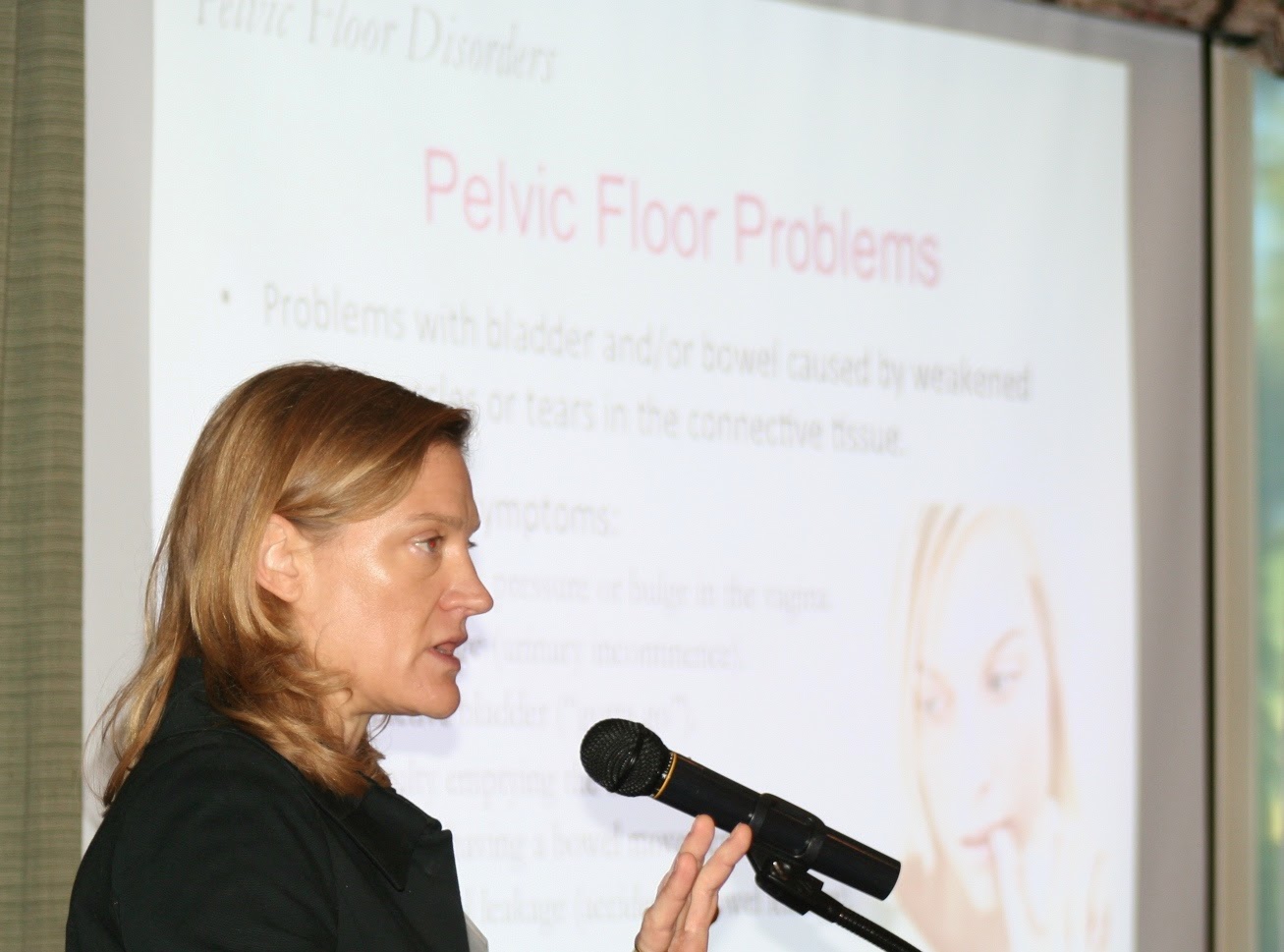Pelvic Floor Disorders: You DON’T have to live with them!
 |
| Dr. Lukacz presenting the most recent information on pelvic health at the last Howell Luncheon |
Creating awareness on pelvic floor health starts with
education. The Howell Foundation hosted Dr.
Emily Lukacz last week who gave a very informative summary on what comprises pelvic floor
disorders, understanding the basic anatomy of incontinence and its symptoms, and the latest on treating these disorders.
If we were to summarize her most important
message it would be the fact that one does not have to live with pelvic floor
disorders, especially when one out of three women suffer from it – a message
worthwhile sharing since pelvic floor
disorders are under reported and
therefore under served.
“It’s not only
women who suffer from these conditions. Family suffers as well. Reality is there are lots of fairly simple
things you can do that don’t require surgery”, she stated. “Being here and spreading the word on pelvic
floor health is the first step”.
The main conditions that characterize pelvic floor
disorders are Incontinence (Urinary and Fecal) and Prolapse; both with
lifestyle common risk denominators such as vaginal delivery, traumatic events
such as stoke or dementia --where the incident prevents the brain from
controlling the muscles and nerves, lifestyle conditions such as obesity or
smoking, chronic straining and heavy lifting, and injury to pelvic nerves
through pelvic surgery. Surprisingly
enough, symptoms of pelvic floor conditions can be managed more often than not with
behavioral therapies such as exercising, dietary changes and learning about the
different alternatives to managing incontinence and prolapse.
The following staggering statistics help create
awareness on the many effects that incontinence has in 1 out of 3 women helps create awareness on pelvic floor health. Did you know that:
- 18 million women in the US have an incontinence problem?
- There are more adult diapers than baby diapers in any given grocery aisle?
- 11 million diapers are dumped in landfills every day?
- More money is spent on diapers and cleaners than treating the problem, which is significantly more affordable?
The description of common pelvic floor disorders, the risks and alternative therapies to treating the condition made this presentation one of its kind. “The fact that Dr. Lukacz delivered highly informative information on such a delicate and personal matter and during lunch earned her my respect” comments a Fiend of Howell. “Attending the Howell events is a huge resource to find out about the latest in women’s health”.
Urinary Incontinence
Understanding the types of urinary incontinence starts with
knowing about symptoms, summarized as:
- Pressure or bulge in the vagina
- Difficulty emptying the bladder
- Difficulty emptying the bowel
- Having that “gotta-go” feeling (overactive bladder)
- Leakage
As for the causes of incontinence, some people are at a
higher risk than others. Typically
considered as part of aging, incontinence may not be a consequence of aging
alone. Genetics are involved and lifestyle
definitely plays a role.
Urinary incontinence is related to the balance between the
brain and the bladder, and to the strength of the muscles that hold the urine flow. Typically
the normal condition of the bladder is relaxed while the urethra is tight. When it is time to go, the bladder tightens
and the urethra relaxes. These reflexes
are coordinated by the brain. Incontinence happens when the muscles are too weak to work properly.
Urinary incontinence
– or overactive bladder syndrome-- takes place when the balance between muscles
and nerves is altered--the nerves
are hyperactive and over-responding to any given stimulus. The symptoms include small
or large volume of leakage, slow or intermittent urinary stream, leaking when one sneezes,
lifts, coughs or laughs and a strong feeling of wanting to go or feeling you
haven’t gone enough. On the other hand,
stress incontinence is characterized by the urethra being stressed, – or using Dr. Lukacz's analogy, like stepping on a hose.
Worthwhile mentioning is the fact that 40 to 50 percent of
women have both types of incontinence, and that it is very important to
understand the differences between both as one type can get worse if the other
is treated. Clear and concise
communication with your physician is key, regardless of how awkward the
conversation might be!
As for treatments, Dr. Lukacz commented that surgery should
be a last resort and only after all other alternatives have been exhausted. Her
recommendations for treating incontinence are focused on behavioral changes:
- Leading a healthier lifestyle, losing weight and smoking cessation among the main recommendations.
- Knowing what is normal and what is not: going 8 times per day and 1 per night is typically normal. If one sees changes in frequency, she recommends seeking a physician.
- Holding it for a long time will have an effect on your pelvic health.
- Limiting bladder irritants, such as alcohol, spicy foods and fluids like soda or coffee.
- Mind the delicate balance between drinking too much or too little water. On the one hand, if you drink too much, you will want to go all the time; if you don’t, the toxins that are meant to be disposed of can irritate the bladder.
- Become aware of your bladder. Keeping a diary helps create awareness and consciousness.
- Strengthen the pelvic floor muscles with Kegel exercises -- typically recommended 3 sets of 10 daily.
- Retraining the bladder and getting it under a routine: program when to go; for example, every hour and increasing bathroom breaks by 15-minute intervals.
- Holding and squeezing, and then going vs. rushing to go as soon as we feel the need.
- Using pessaries that help hold the internal organs.
- Talking to your physician on the use of medication. Statistics show that 70% of patients will see symptom relief.
As for procedures for incontinence condition, Dr. Lukacz
commented that standardization of 20-minute, minimally invasive procedures are
successful 80 to 90 percent of the time and are available in office
settings. Other forms of incontinence
procedures include bulking injection (Botox gel, 70% effective in decreasing incontinence
symptoms), retro-pubic intervention and acupuncture for the bladder. Ultimately, understanding what you can do is
crucial to take care of bladder incontinence.
Fecal Incontinence
It is important to realize that the withdrawal due to fecal
incontinence has a bigger impact than urinary incontinence. But there is hope for the 20% of women with bowel
leakage problems: it can be resolved and is supported by dietary changes.
Fecal incontinence shows the same kind of restrictions as urinary
incontinence so they often go hand in hand.
As with urinary incontinence, damage to the muscle at child birth or
colorectal surgeries are going to have an effect how a woman can control their bowel movements. Chronic straining due to constipation can also result in
pelvic floor disorders.
It is important
to keep track of our bowel movements to determine if it is caused by an
underlying problem. The typical symptoms of fecal incontinence can include
difficulty holding loose stool, constipation, or going back and forth from
constipation to diarrhea.
The first of Dr. Lukacz’s recommendations is
the use of fiber supplementation.
Contrary to popular belief, fiber supplementation helps constipation as
much as it helps diarrhea. The body needs at
least 35 mg. of fiber and organic fiber is typically more effective due to its absorption
effect.
In addition to fiber supplementation, Dr. Lukacz
additionally recommends following a healthy diet. Avoiding spicy foods in case of a loose stool
or starchy foods in case of constipation will help to manage fecal incontinence
symptoms. Kegel exercises will help with
strengthening the pelvic muscles and should help ease the uncomfortable
symptoms of the disorder.
As uncomfortable as it seems, accurate treatment for fecal
incontinence is still at its early stages.
According to Dr. Lukacz, treatment for fecal incontinence is at a stage
where urinary incontinence was 20 years ago!
As a matter of fact, clinical trials that explore treatment --exercise
vs. surgery -- are currently in process today. The
new trends in 2015 that are currently being investigated as effective, additional treatments for fecal incontinence include special designs of insert
devices, radio frequency, nerve stimulation, reconstruction surgery and bulking
injections.
Prolapse
According to Dr. Lukacz, half the women ages 50 -70 suffer some form of organ prolapse. Organs prolapse when the muscles and
ligaments holding them together stretch inside the pelvis. However, as long as the
prolapsed organs stay within the opening of the vagina it is typically not
symptomatic. In fact, 80% of the time prolapse will stay the same year to year, 15% of the time it will get
worse, and 5% of the time it will get better.
Being bothered by organ prolapse becomes a
quality of life issue. As for risks and
causes of prolapse, the recurring themes include childbirth, straining, obesity
and some type of pelvic surgery, such as a hysterectomy.
The most common symptoms of organ prolapse include:
- Pressure
- Heaviness in the pelvic/abdominal area
- Something falling from the vagina
- Difficulty initiating urination or emptying our bowels
- Pain during intercourse
- Pressure from feeling the bulge
Getting familiar with the terms cystocele and rectocele is
important as they are the most common forms of organ prolapse. A
rectocele is a bulging of the front wall of the rectum into the back wall of
the vagina. Rectoceles are
usually due to thinning of the recto-vaginal septum (the tissue between the
rectum and vagina) and weakening of the pelvic floor muscles. A
cystocele occurs when the supportive tissue between a woman's bladder and
vaginal wall weakens and stretches, allowing the bladder to bulge into the
vagina.
As for recommending surgery, Dr. Lukacz offers strong words
of caution: no one single surgery works
for every woman. Surgery for organ prolapse will depend on
various factors: what your goals are, your level of investment in surgery, recovery
time and how long will the fix last.
Surgery should focus on restoring a normal anatomy, getting rid of the
bulge and increasing our quality of life.
For additional resources on anything and everything related
to pelvic floor health, Dr. Lukacz recommends visiting Voices for Pelvic Floor Disorders.org
About Dr. Emily Lukacz:
Dr. Lukacz has completed three years of fellowship training in
the subspecialty of Female Pelvic Medicine and Reconstructive Surgery and joined
the UC San Diego Women's Pelvic Medicine Center in 2003. She focuses her
efforts on evaluating and treating women with urinary incontinence, pelvic
organ prolapse and other pelvic floor disorders.
About the Doris A. Howell Foundation:
The Doris A. Howell Foundation for Women’s Health Research is
committed to keeping the women we love healthy, advancing women’s health
through research and educating women to be catalysts for improving family
health in the community.
The organization does so by funding scholarships to
scientists researching issues affecting women’s health; providing a forum for medical experts,
scientists, doctors, researchers, and authors to convey the timely information
on topics relevant to women’s health and the health of their families through its
Lecture and Evening Series, and by funding research initiatives that will
create women’s health awareness and advocacy in the community. For more information about the Doris A.
Howell Foundation, please visit www.howellfoundation.org.



Comments
Post a Comment